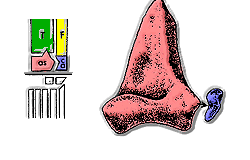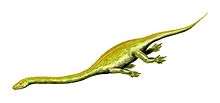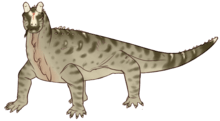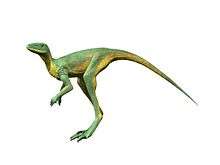Avemetatarsalia
Avemetatarsalia (meaning "bird metatarsals") is a clade name established by British palaeontologist Michael Benton in 1999 for all crown group archosaurs that are closer to birds than to crocodilians.[1] An alternate name is Pan-Aves, or "all birds", in reference to its definition containing all animals, living or extinct, which are more closely related to birds than to crocodilians. Almost all avemetatarsalians are members of a similarly defined subgroup, Ornithodira. Ornithodira is defined as the last common ancestor of dinosaurs and pterosaurs, and all of its descendants.[2]
| Avemetatarsalians | |
|---|---|
 | |
| Clockwise from top-left: Tupuxuara leonardi (a pterosaur), Alamosaurus sanjuanensis, (a sauropod), Tsintaosaurus spinorhinus (an ornithopod), Daspletosaurus torosus (a tyrannosaur), Pentaceratops sternbergii (a ceratopsian), and Grus grus (an extant avian). | |
| Scientific classification | |
| Kingdom: | Animalia |
| Phylum: | Chordata |
| Clade: | Sauropsida |
| Clade: | Archosauria |
| Clade: | Avemetatarsalia Benton, 1999 |
| Subgroups | |
| |
| Synonyms | |
Members of this group include the Dinosauromorpha, Pterosauromorpha, the genus Scleromochlus, and Aphanosauria. Dinosauromorpha contains more basal forms, including Lagerpeton and Marasuchus, as well as more derived forms, including dinosaurs. Birds belong to the dinosaurs as members of the theropods. Pterosauromorpha contains Pterosauria, which were the first vertebrates capable of true flight. Aphanosauria is a Triassic group of gracile carnivorous quadrupeds which was recognized in 2017.[3]
Description

The foundational characteristic is the "advanced mesotarsal" ankles, which are characterized by a large astragalus and a small calcaneum. This ankle orientation operated on a single hinge, allowing for better mobility. Probably as a result of this change, the common ancestor of the avemetatarsalians had an upright, bipedal posture, with their legs extending vertically, similar to that of mammals.
Feathers and other filamentary structures are known across the avemetatarsalians, from the downy pycnofibers of pterosaurs, to quill-like structures present in ornithischian dinosaurs, such as Psittacosaurus and Tianyulong, to feathers in theropod dinosaurs and their descendants, birds.
Two clades of avemetatarsalians, pterosaurs and birds, independently evolved flight. Pterosaurs are the earliest vertebrates known to have evolved powered flight. Their wings are formed by a membrane of skin, muscle, and other tissues stretching from the ankles to a dramatically lengthened fourth finger.[4] Birds evolved flight much later. Their wings formed from elongated fingers and their arms, all covered with flight feathers.
Avemetatarsalians were generally lighter built than crocodile-line archosaurs. They had smaller heads and usually a complete lack of osteoderms.
Origin
Bird-line archosaurs appear in the fossil record by the Anisian stage of the Middle Triassic about 245 million years ago, represented by the dinosauriform Asilisaurus. However, Early Triassic fossil footprints reported in 2010 from the Świętokrzyskie (Holy Cross) Mountains of Poland may belong to a more primitive dinosauromorph. If so, the origin of avemetatarsalians would be pushed back into the early Olenekian age, around 249 Ma. The oldest Polish footprints are classified in the ichnogenus Prorotodactylus and were made by an unknown small quadrupedal animal, but footprints called Sphingopus, found from Early Anisian strata, show that moderately large bipedal dinosauromorphs had appeared by 246 Ma. The tracks show that the dinosaur lineage appeared soon after the Permian–Triassic extinction event. Their age suggests that the rise of dinosaurs was slow and drawn out across much of the Triassic.[5] The primitive traits found in the quadrupedal aphanosaur Teleocrater shows that the earliest avemetatarsalians had many pseudosuchian-like features, and that the traits typical for the group evolved later.[6]
Classification
In 1986, Jacques Gauthier defined the name Ornithosuchia (previously coined by Huene) for a branch-based clade including all archosaurs more closely related to birds than to crocodiles.[2] In the same year, Gauthier also coined and defined a slightly more restrictive node-based clade, Ornithodira, containing the last common ancestor of the dinosaurs and the pterosaurs and all of its descendants. Paul Sereno in 1991 gave a different definition of Ornithodira, one in which Scleromochlus was explicitly added.[7] It was thus a potentially larger group than the Ornithodira of Gauthier. In 1999 Michael Benton concluded that Scleromochlus was indeed outside Gauthier's original conception of Ornithodira, so he named a new branch-based clade for this purpose: Avemetatarsalia, named after the birds (Aves), the last surviving members of the clade, and the metatarsal ankle joint that was a typical character of the group. Avemetatarsalia was defined as all Avesuchia closer to Dinosauria than to Crocodylia. In 2005, Sereno stated the opinion that Ornithodira was not a useful concept, whereas Avemetatarsalia was. In 2001, the same clade was given the name Pan-Aves (meaning "all [pan in Greek] birds" [aves in Latin]), coined by Jacques Gauthier. He defined it as the largest and most inclusive clade of archosaurs containing Aves (birds, anchored on Vultur gryphus) but not Crocodylia (anchored on Crocodylus niloticus). Gauthier referred Aves, all other Dinosauria, all Pterosauria, and a variety of Triassic archosaurs, including Lagosuchus and Scleromochlus, to this group.[8]
In a 2005 review of archosaur classification, Phil Senter attempted to resolve this conflicting set of terminology by applying strict priority to names based on when and how they were first defined.[9] Senter noted that Ornithosuchia, the earliest name used for the total group of archosaurs closer to birds than to crocodiles, should be the valid name for that group, and have precedence over later names with identical definitions, such as Avemetatarsalia and Pan-Aves. While this has been followed by some researchers, others have either continued to use Avemetatarsalia or Ornithodira, or have followed Senter only reluctantly. Mike Taylor (2007) for example noted that, while Senter is correct in stating that Ornithosuchia has priority, this is "undesirable" because it probably excludes the eponymous family Ornithosuchidae, and questioned the utility of using priority before the PhyloCode is implemented to govern it.[10] In fact, the name Ornithosuchia may be "illegal" under the PhyloCode because it does not include its eponymous taxon as part of its definition.[10]
Cladogram after Nesbitt et al. (2017),[3] with clade names from Cau (2018).[11]
| Archosauria |
| ||||||||||||||||||||||||||||||||||||||||||||||||
References
- Benton, M.J. (1999). "Scleromochlus taylori and the origin of dinosaurs and pterosaurs". Philosophical Transactions of the Royal Society B: Biological Sciences. 354 (1388): 1423–1446. doi:10.1098/rstb.1999.0489. PMC 1692658.
- Gauthier, J. A. (1986). "Saurischian monophyly and the origin of birds." The Origin of Birds and the Evolution of Flight, K. Padian (ed.), Memoirs of the California Academy of Sciences 8:1–55 [M. Carrano/M. Carrano/M. Carrano]
- Nesbitt, Sterling J.; Butler, Richard J.; Ezcurra, Martín D.; Barrett, Paul M.; Stocker, Michelle R.; Angielczyk, Kenneth D.; Smith, Roger M. H.; Sidor, Christian A.; Niedźwiedzki, Grzegorz; Sennikov, Andrey G.; Charig, Alan J. (2017). "The earliest bird-line archosaurs and the assembly of the dinosaur body plan" (PDF). Nature. 544 (7651): 484–487. doi:10.1038/nature22037. PMID 28405026.
- Elgin RA, Hone DW, Frey E (2011). "The Extent of the Pterosaur Flight Membrane". Acta Palaeontologica Polonica. 56 (1): 99–111. doi:10.4202/app.2009.0145.
- Brusatte, S.L.; Niedźwiedzki, G.; Butler, R.J. (2010). "Footprints pull origin and diversification of dinosaur stem lineage deep into Early Triassic". Proceedings of the Royal Society B. 278 (1708): 1107–1113. doi:10.1098/rspb.2010.1746. PMC 3049033. PMID 20926435.
- Dinosaur Evolution: Crocodile-Like Ancient Cousin, Teleocrater Rhadinus, Confuses Scientists
- Sereno, P. C. 1991. Basal archosaurs: phylogenetic relationships and functional implications. Journal of Vertebrate Paleontology Memoir 2, 11(4, Supplement):1–53.
- Gauthier, J. and de Queiroz, K. (2001). "Feathered dinosaurs, flying dinosaurs, crown dinosaurs,and the name "Aves"". pp. 7–41 in Gauthier, J. and L. F. Gall (eds.), New Perspectives on the Origin and Early Evolution of Birds: Proceedings of the International Symposium in Honor of John H. Ostrom. New Haven: Peabody Museum of Natural History, Yale University. ISBN 0-912532-57-2.
- Senter, P. (2005). "Phylogenetic taxonomy and the names of the major archosaurian (Reptilia) clades". PaleoBios. 25 (3): 1–7.
- Taylor (2007). "Phylogenetic definitions in the pre-PhyloCode era; implications for naming clades under the PhyloCode" (PDF). PaleoBios. 27 (1): 1–6.
- Andrea Cau (2018). "The assembly of the avian body plan: a 160-million-year long process" (PDF). Bollettino della Società Paleontologica Italiana. 57 (1): 1–25. doi:10.4435/BSPI.2018.01.
Sources
- Michael J. Benton (2004). "Origin and relationships of Dinosauria". In David B. Weishampel; Peter Dodson; Halszka Osmólska (Hrsg.) (eds.). The Dinosauria. Berkeley: Zweite Auflage, University of California Press. pp. 7–19. ISBN 0-520-24209-2.









